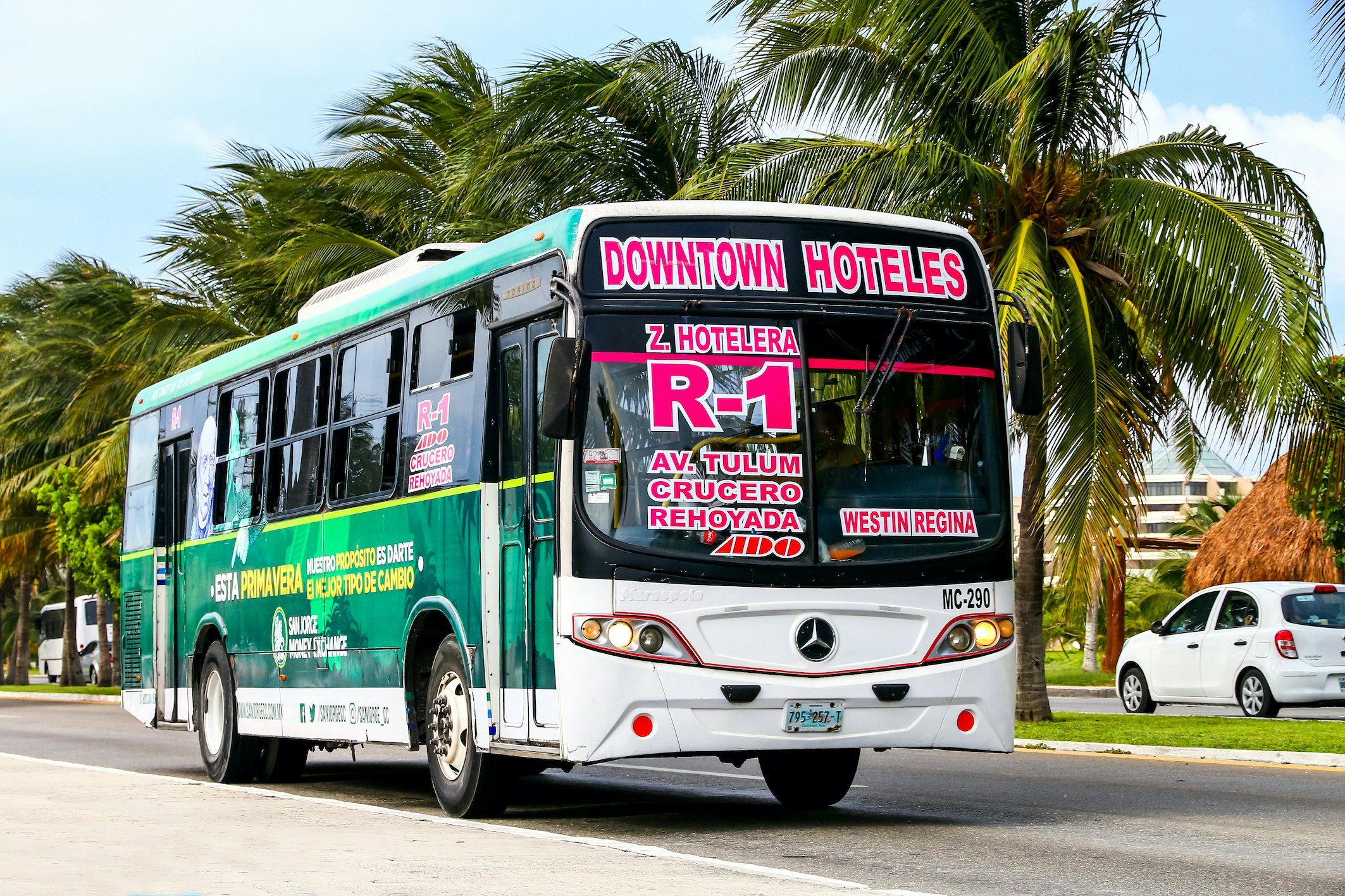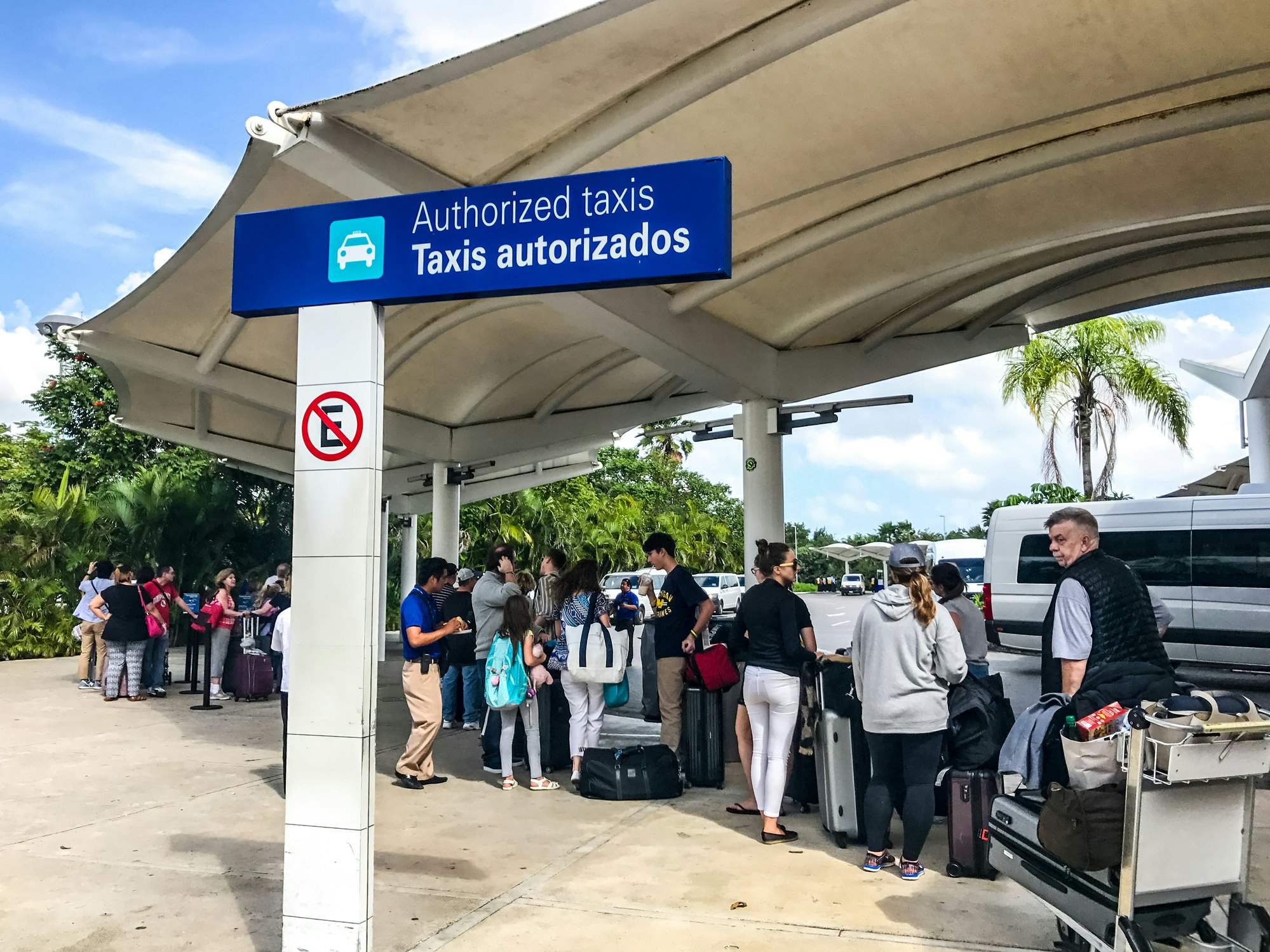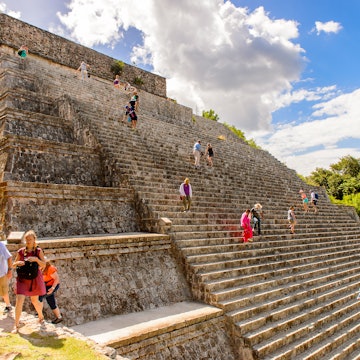

There are tons of affordable options for getting around Cancún. Leonard Zhukovsky / Shutterstock
Cancún has two key areas to navigate – the Zona Hotelera, known for its glamorous, sky-high resorts lining the powdery beaches and a buzzing party scene in bars and nightclubs that keep going until dawn, and downtown Cancún, a thriving neighborhood filled with government offices and a locally focused, vibrant social scene all of its own.
It’s easy to get around both districts, but they’re quite different. Downtown Cancún is compact, congested and best seen on foot. Meanwhile, the Zona Hotelera sprawls across 22.5km (14 miles), and although the nightlife is centered in one area it is still most convenient to travel by bus or cab.
Start planning your to-do list now with our guide to getting around Cancún.
Stretch your legs and join the party
In the Zona Hotelera, most of the action – the glitzy dance clubs, bars and DJ-driven beach clubs – is clustered around Punta Cancún, the "elbow" in the peninsula.
Hot spots like The City, Congo Bar and Mandala Beach sit within a stone’s throw of each other, connected by wide, well-maintained sidewalks and lit up by giant neon signs – walking is the easiest way to join the fun as you go from bar to bar.
The rest of the Zona Hotelera is lined with resorts and condominiums with restaurants and malls dotted along the way; it spans from the Puerto Cancún Marina Town Center near downtown to Ventura Park near the airport – too far to cover on foot.
Likewise, downtown Cancún’s social center is in the compact southeastern quadrant – home to Avenida Náder and Plaza de Toros, with trendy bars and restaurants – and Parque de las Palapas, the bustling main plaza.
The distances between them are short, with some pedestrian-only sections. Add the often bumper-to-bumper traffic into the mix and walking is the natural, easy option.
Join the locals on a colectivo
Locals ride colectivos (shared minivans) to get to neighborhoods that city bus routes don’t cover well. There are designated stops, but passengers can get on or off anywhere along the route, which is convenient but can make for a longer journey.
Buses are a budget-friendly way for travelers to get to the windswept beaches and kiteboarding waters of Isla Blanca, just north of the city. One-way fares are far more affordable than other options, and they depart near Parque El Crucero (Av. López Portillo at Calle 7).
Colectivos also service the Isla Mujeres ferry terminal in Puerto Juárez; look for them just outside the ADO bus terminal and be sure to travel light (luggage must be carried on your lap).

Stretch your budget by taking the bus
City buses are the most common way to move around Cancún.
Three routes (R-1, R-2 and R-27) serve Cancún’s most touristy areas, including the resorts and nightclubs in the Zona Hotelera and the gorgeous Playa Delfines, El Rey Archaeological Zone and Museo Maya de Cancún.
Look for the red buses with "Hoteles" and "Zona Hotelera" signage along Avenida Tulum or Avenida Cobá in downtown Cancún or along Boulevard Kukulcán in the Zona Hotelera; there are bus stops every few blocks. The R-1 bus also travels north to the Isla Mujeres ferry terminal in Puerto Juárez.
Ride the ferry for spectacular views
Sure, Cancún’s ferries are primarily a way to reach the gorgeous Isla Mujeres, but consider taking the 30-minute ride just for the breathtaking views: luminescent turquoise waters surround the boat, white sand and palm trees line the coasts, and Cancún's high-rise hotels stand like sentinels in the distance.
Head to the top floor for outdoor seating and, often, live music. Drinks and snacks are sold on board. Two passenger ferries leave from the Zona Hotelera (at Playa Tortugas and Playa Caracol) and one from downtown Cancún (at Puerto Juárez). The ride is M$290 (US$14.12) each way.

Hail a cab, day or night
Cabs are easy to find in Cancún – taxi stands exist everywhere travelers do, from resorts and shopping centers to the bus station and ferry terminals. They’re also easily hailed on main thoroughfares, passing every few minutes.
The city sets fares, though taxi drivers are notorious for inflating the rates – always agree on the price before you set off. Ask your hotel concierge what the cost should be if you're unsure.
Generally, rates are more affordable tp travel around downtown, getting more expensive in the Zona Hotelera and between the two. Be aware that if you take a cab from a taxi stand or after sunset, a surcharge will be added, sometimes doubling the daytime rate.
For door-to-door service, try a rideshare
Uber and Cabify provide comfortable rides and are often cheaper than taxis in Cancún. Their reach is limited, however, by the powerful taxi union – rideshares aren’t permitted to pick up at the airport, ferry terminals or any place serviced by a taxi stand, including Zona Hotelera resorts. Drop-offs, however, are permitted everywhere.
Check the status of each app before you arrive, as service has been suspended intermittently for years. And if you have trouble securing a ride, it likely means you’re near a taxi stand – just cross the street or walk a block… that usually does the trick!

Driving is rarely worth the hassle
There’s no need for a rental car in Cancún. Traffic can be unrelenting and parking scarce. Plus, there are plenty of alternatives for getting around. But if you can’t live without your own wheels, find the best rates online with an agency in Cancún proper or just outside the airport area (the airport taxes are hefty).
Hotels often have designated parking spots for their guests but may charge a nightly fee. Street parking is always an option in downtown Cancún but runs the risk of damage or theft to the vehicle.
For hourly parking, head to Cancún’s shopping centers or Parque de las Palapas.
Accessible transportation in Cancún
It can be a challenge for travelers with mobility issues to navigate Cancún, especially downtown, where the sidewalks can be narrow and uneven, and curb ramps are almost nonexistent.
Similarly, colectivos, buses and ferries aren’t retrofitted for people with disabilities. Rideshares and taxis can be a good option; drivers – and Mexicans in general – are typically willing to lend a helping hand. If it fits your budget, Cancun Accessible provides transportation services and tours to travelers with disabilities.
Travel to and from Cancún Airport on a budget
With cab fares pushing M$1200 (US$50) and shuttles eternally slow, the bus is a reliable and budget-friendly way to access Cancún’s airport.
ADO provides comfortable, air-conditioned bus rides to the airport in just 30 minutes. They leave every half-hour from the downtown bus station. Upon return, purchase tickets at ADO kiosks inside the airport or near each terminal’s bus stop.
















